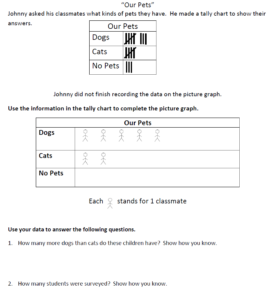MAFS.1.MD.3.4 Organize, represent, and interpret data with up to three categories; ask and answer questions about the total number of data points, how many in each category, and how many more or less are in one category than in another.
Cognitive Complexity Level: 1-Recall
[divider] [/divider] Students are able to…
- Create questions to ask relating to a table or chart
- Create a table or chart
- Collect data
- Compare data by using most, least and other comparison words
[divider] [/divider] Students are able to…because teachers:
- Model questioning and vocabulary related to charts and tables
- Provide opportunities for student to create questions about charts and tables
- Provide opportunities for students to collect data and make comparisions
[divider] [/divider] Questions to ask students:
- Ask: Looking at a chart or graph – Which category has the more? Which category has the least?
- Sample answer that indicates understanding: Student correctly identifies the category with the most and the least.
- Ask: What could be the possible categories if the question was “What is your favorite color?” How could we collect this data?
- Sample answer that indicates understanding: We could make the categories Blue, Yellow and Green. We can ask each person in the class and write their name next to the color that is their favorite.
[divider] [/divider] Additional Resources:
Additional in depth content knowledge
[divider] [/divider] Sample Formative Assessment Tasks:
[divider] [/divider] Resources/Tasks to Support Your Child at Home:
- Task: Look for data charts or tables with data in the newspaper or in magazines. Ask your child questions related to the data.
- Task: Have your child collect data about objects in your home, including:
- Tally the number of pennies, nickels, dimes and quarters in the coin jar.
- Tally the red, orange, yellow, green, blue and purple Fruit Loops.
- Online Task: Organize and Interpret Data
